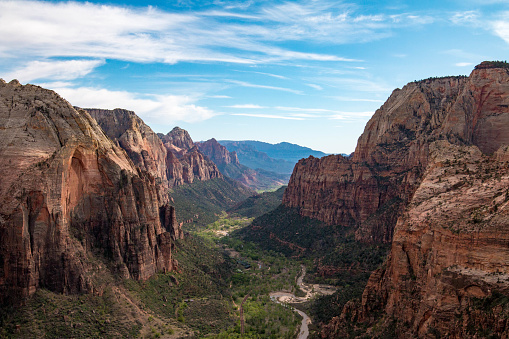Zion National Park, located near St. George and Springdale, Utah, is 30 miles in length and 15 miles across at its widest point, totaling 148,000 acres. Elevations range from 4,000 to 8,700 feet yet there are plenty of ways to access and enjoy the park. It may seem like #1 accolades are common-place in Zion National Park, but the world is really just starting to learn about the vast scenic treasures of this region.
Hiking is probably the most popular of activities in Zion. The more active hiker will love trails such as Angels Landing (5-mi. roundtrip), the Watchman (2.7-mi. Round-trip) and Observation Point (8-mi. round-trip). Bikes can be rented locally in Springdale and visitors can ride the Pa’rus trail within the park. This may be one of the best ways to see the main canyon of Zion National Park in a relatively short time. Take all the time you want and bring your camera, water and some snacks in your day-pack.
Climbing, canyoneering, and photography are also activities in the area. Don’t miss out on the Zion Canyon Theatre for relaxing and watching movies in the evening. The drastic elevation difference in Zion National Park provides many types of habitat including grassland, desert, wetland, riparian, and forest. These habitats support many species of plants and animals. There are 67 species of mammals found in Zion National Park, 13 species of snakes, 291 species of birds, 4 fish species native to the area, and 900 species of plants.
Don’t forget local museums and galleries! See masterpieces at The LaFave Gallery & Worthington Gallery. Get information about Zion Parks history at the Zion Canyon Visitor Center, the Kolob Canyon History Center, and the Zion Human History Museum.
ANGELS LANDING
The trail to Angels Landing is 2.4 miles long. It begins at the Grotto drop off point on the park’s shuttle system. After a series of steep switchbacks, the trail goes through the area between Angels Landing
and the Zion Canyon. The next section – Walter’s Wiggles, a series of 21 steep switchbacks, is the final paved section before the real work begins. “Scout Lookout” is generally the turnaround point for
those who are unwilling to make the final summit push to the top of Angels Landing. The last half-mile of the trail is strenuous and has sharp drop offs and narrow paths on both sides. Chains to grip are
provided for portions of the last half-mile to the top at 5,790 feet.
HISTORY OF ZION NATIONAL PARK
Zion National Park receives nearly 3 million visitors every year. These guests enjoy a beautiful, ecologically friendly visitor center, shuttle service, campsites and friendly park rangers to provide direction and education. This beautiful, diverse area has a rich history of human habitat spanning at least 8,000 years. The first humans known to have settled in the region were small groups of hunter/gatherers in around 6,000 B.C.. Though little is known about these people, some artifacts such as baskets, sandals and knives have been found in caves.
Around 300 B.C., people began to plant corn and squash. This rudimentary farming allowed them to settle in more permanently, building small dwelling. Between 500 and 1300 A.D., the Virgin Anasazi and the Parowan Freemont lived in the area. These peoples built pueblos, hunted, farmed, created artistic pots and formed social relationships. Droughts in the 11th and 12th centuries may have pushed these Native Americans out of the region, in search of water. Southern Paiute and Ute tribes inhabited the area seasonally. They hunted and planted corn, squash and sunflowers, and gathered seeds and local plants.
Brigham Young, the leader of the Church of Jesus Christ of Latter Day Saints (Mormons) brought members of his church to the Salt Lake Valley in 1847. Throughout the next decade, he sent parties to settle in parts of southern Utah and many settled near the area that would become Zion National Park. The towns of Springdale, Grafton, and Paradise cropped up. In 1863, Issac Behunin built the first log cabin in Zion Canyon and planted corn, tobacco and fruit trees
